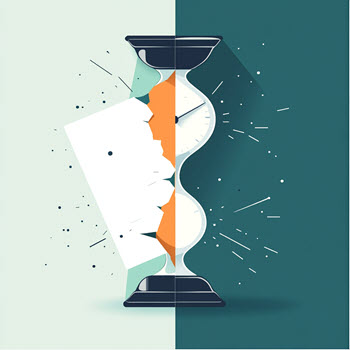When prospects download or otherwise request gated content (like a white paper, for example), do they generally read that content immediately?
Not according to a recent report from NetLine, who use prospect behavior on their buyer engagement platform to measure what they call the “Consumption Gap,” the time between when content is requested and when that content is opened for consumption.
According to NetLine’s 2025 State of B2B Content Consumption & Demand Report (link here – registration required), the Consumption Gap increased in 2024 to 39 hours—a 23% YOY rise. Translated, that means when someone fills out a form to download a white paper from your website say, it’s almost two whole days on average before that content is actually opened and read.
This eye-opening fact stands in stark contrast to how most gated content requests are fulfilled and managed, namely:
* prospects who fill out a form online are typically directed to the content as a hosted PDF
* nurture emails, if not actual sales follow-up, usually trigger immediately
The issue here isn’t a lack of responsiveness—it’s that most lead follow-up happens before the content is ever read, making it poorly timed and often ineffective:
When you direct someone to a hosted PDF, you’re forcing that individual to either a) read the content immediately, or b) save it for later consumption. Based on NetLine’s study, most prospects don’t read the content immediately—especially on a mobile device—and so the individual (assuming he or she is sufficiently motivated, hardly a given) has to save the content. Either way, you’re mandating an extra step and creating an inconvenience for the user.
The Consumption Gap & What It Means for Your Content Strategy Share on XIt’s long understood that prompt response to new leads has an outsized effect on the rate at which those leads convert, but if a prospect receives nurture emails or even outreach from a BDR before he or she has even read the content, then the chances of that individual responding positively is greatly diminished. Worst case, it creates an annoyance that sets a tone for the relationship that will deter any future attempt to engage.
Rethinking Gated Content Fulfillment: A More Buyer-Centric Model
Here’s how B2B marketers can adjust their content and lead follow-up strategies to reflect the consumption gap:
Don’t send the individual directly to hosted content. Instead, direct them to a “thank you page” that acknowledges their interest, provides related content (or other relevant “next steps”), explains where to go with questions, and then (critically) informs them that a link to the requested content has been sent to the email address they provided.
Send that “fulfillment email” with a direct link to the PDF, and a version of the same information that was on the thank you page: thank you for your interest, related content, possible next steps, where to go with questions.
5 Ways This Approach Improves Conversion Rates
Here’s why the thank you page + fulfillment email strategy is the best way to respond to gated content requests:
1. It helps ensure you’re capturing a valid email address, reducing junk leads. (If this feels punitive or adversarial, you can also provide a link to the content on the thank you page.)
2. Critically, the email—and a link to the content requested—will reside in the prospect’s inbox to be opened and consumed when convenient, rather than forcing the individual to save the hosted PDF.
3. Sending a link to the content increases the likelihood that it will be forwarded to colleagues, increasing that content’s reach.
4. By providing related content and possible next steps (questions, a related Webinar, demo request) on both the thank you page and in the fulfillment email, you provide qualified prospects or active buyers the opportunity to re-engage immediately.
5. By tracking when the prospect clicks on the link in the fulfillment email, you can trigger follow-up (a sales call or additional email) only when you know the prospect has actually read the white paper. Alternatively, if the prospect hasn’t clicked on the link within say, 2 days, you can send a friendly reminder email (perhaps as a personal note from the assigned rep), automatically.
Yes, creating a thank you page and fulfillment email for every gated asset is more work. But both can be templates that version quickly and easily, minimizing the extra effort. Meanwhile, the reward is a follow-up process that better reflects how and when buyers consume content, and increases the likelihood of converting prospects into sales-ready opportunities. It’s a simple shift that can dramatically improve both content utilization and lead conversions.

